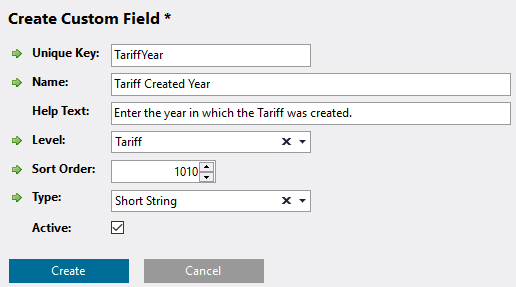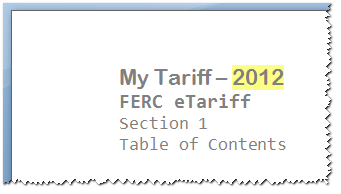TariffShark Tiger User Guide
Not your version? Custom Field
Custom Field
A Custom Field provides the ability to store data that TariffShark wasn't specifically designed to capture. For example, if you wanted to record the year that a Tariff was first created, you could create a Custom Field for that. You might fill out the Create Custom Field screen as shown below.

Then, when creating or updating a Tariff, on the Custom Fields tab, you could enter a value for the Custom Field:

Also, if you wanted to include the year that a Tariff was created in a Header Template, TariffShark provides a Symbol entered as [CustomField_"UniqueKey"] for including Custom Field data within Headers and Footers. Such a Header Template might look like this:

When editing the content of a Tariff Record Version that uses the Header Template above, it would look like this:

Data That Defines a Custom Field
Unique Key
A short string consisting of upper case characters, lower case characters, and numeric digits that uniquely distinguishes a Custom Field from all others. Special characters and spaces may not be used in a Unique Key.
Name
The name of a Custom Field.
Help Text
Instructive text to help data entry personnel to enter meaningful values into Custom Fields.
Level
The TariffShark element to which a Custom Field applies. Valid values are Company, Filing, Tariff, Tariff Database, Tariff Record, and Tariff Record Version.
Sort Order
Specifies the order in which multiple Custom Fields belonging to the same Level will appear within the TariffShark user interface. Custom Fields are presented in lower Sort Order to higher Short Order sequence.
Type
The type of data that will be stored in a Custom Field. Valid values are:
- Short String (30 or fewer characters)
- Required Short String (30 or fewer characters; cannot be left blank)
- Long String (200 or fewer characters)
- Required Long String (200 or fewer characters; cannot be left blank)
- Multi-line String (2,000 or fewer characters)
- Required Multi-line String (2,000 or fewer characters; cannot be left blank)
- Date
- Required Date (cannot be left blank)
- Integer (a whole number between 0 and 2,147,483,647; once a value is entered, it can be deleted using the shortcut Ctrl-Delete rather than highlighting the value and hitting Delete which will result in a replacement value of zero (0)).
- Required Integer (a whole number between 0 and 2,147,483,647; cannot be left blank)
- Checkbox
Active?
Active Custom Fields participate fully in TariffShark (for example, users may update and view their values). Inactive Custom Fields are omitted from the TariffShark user interface (as if they didn't exist).
Related Elements
None.